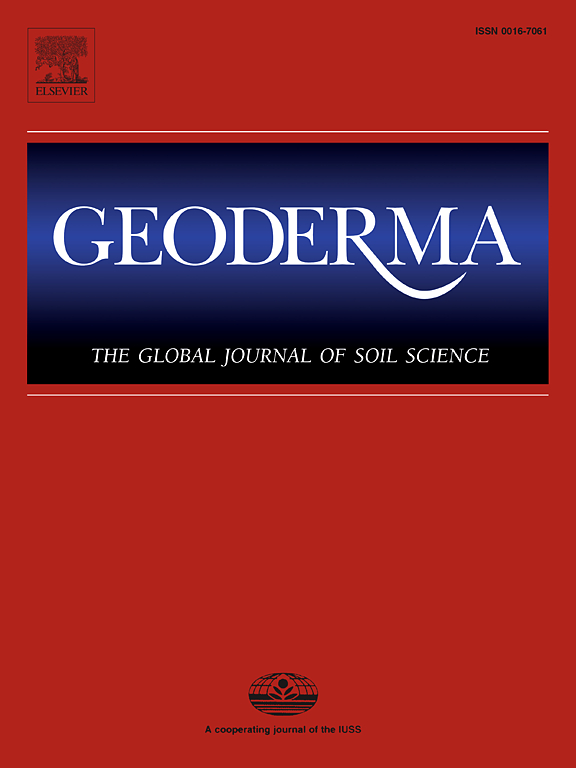Changes in the soil and rhizosphere microbiomes associated with bacterial wilt decline in the tomato monoculture field
IF 5.6
1区 农林科学
Q1 SOIL SCIENCE
引用次数: 0
Abstract
Monoculture farming streamlines field equipment use and increases the efficiency of planting and harvesting, but at the same time, exacerbates the severity of soilborne diseases. Disease-suppressive soils are an effective and sustainable resource for managing soilborne diseases in monoculture systems. However, the evolution and mechanisms of soil suppressiveness remain elusive, limiting the broader acceptance of suppressive soil in agriculture. This study investigated changes in the belowground tomato microbiome during long-term monoculture leading to an outbreak and subsequent suppression of bacterial wilt, a destructive soilborne disease. The wilt incidence steadily increased, culminating in the most severe outbreak in the fifth cropping cycle. Surprisingly, in the seventh crop, wilt symptoms spontaneously declined, signifying a transition toward the disease-suppressive state. This transition involved the enrichment of Streptomyces and trace elements (Mn, Ni) in the bulk soil, accompanied by increased diversity and abundance of Pseudomonas in the rhizosphere. Greenhouse disease assays confirmed that the suppressive soil had significantly lower wilt incidence and shaped a healthy rhizosphere community characterized by reduced prevalence of pathogenic taxa and greater resource utilization diversity, compared to its disease-conducive counterpart. Moreover, functional analysis of the suppressive rhizosphere metagenome revealed enrichment of genes for the synthesis of antibiotics, polysaccharides, nitrogen metabolism, mineral absorption, and energy production. Drenching tomato seedlings with suppressive rhizosphere soil suspensions enriched beneficial rhizosphere microorganisms such as Pseudomonas and Bacillus, improving plant growth and physiological characteristics compared to seedlings treated with conducive rhizosphere soil suspensions. Furthermore, Pseudomonas and Bacillus were isolated and validated for their antagonistic ability against R. solanacearum, demonstrating their inhibitory effect on bacterial wilt in greenhouse trials. This study is among the first to directly demonstrate that long-term tomato monoculture can induce specific soil suppressiveness against Ralstonia wilt, while also revealing the key changes in soil and rhizosphere microbiomes and their function associated with this phenomenon.

番茄单作田土壤和根际微生物群变化与青枯病的关系
单一栽培简化了田间设备的使用,提高了种植和收获的效率,但同时也加剧了土传疾病的严重程度。抗病土壤是单一栽培系统中管理土传疾病的有效和可持续资源。然而,土壤抑制的演变和机制仍然难以捉摸,限制了农业中对抑制土壤的广泛接受。本研究调查了长期单一栽培期间番茄地下微生物组的变化,导致细菌性枯萎病(一种破坏性的土传疾病)的爆发和随后的抑制。青枯病发病率稳步上升,在第5个种植周期爆发最为严重。令人惊讶的是,在第七季,枯萎病症状自发地减轻了,这标志着向疾病抑制状态的过渡。这种转变涉及到块状土壤中链霉菌和微量元素(Mn, Ni)的富集,同时根际假单胞菌的多样性和丰度增加。温室病害试验证实,与有益病害的土壤相比,抑制土壤的枯萎病发病率显著降低,形成了一个健康的根际群落,其特征是致病分类群的患病率降低,资源利用多样性增加。此外,对抑制根际宏基因组的功能分析显示,抗生素合成、多糖、氮代谢、矿物质吸收和能量生产等基因富集。与有益根际土壤悬浮液相比,用抑制性根际土壤悬浮液浇灌番茄幼苗可以丰富有益根际微生物,如假单胞菌和芽孢杆菌,改善植株生长和生理特性。此外,还分离出假单胞菌和芽孢杆菌,并在温室试验中验证了它们对番茄枯萎病菌的拮抗能力,证明了它们对青枯病的抑制作用。这项研究首次直接证明了番茄长期单一栽培可以诱导土壤对青枯病的特异性抑制,同时也揭示了土壤和根际微生物组的关键变化及其与这一现象相关的功能。
本文章由计算机程序翻译,如有差异,请以英文原文为准。
求助全文
约1分钟内获得全文
求助全文
来源期刊

Geoderma
农林科学-土壤科学
CiteScore
11.80
自引率
6.60%
发文量
597
审稿时长
58 days
期刊介绍:
Geoderma - the global journal of soil science - welcomes authors, readers and soil research from all parts of the world, encourages worldwide soil studies, and embraces all aspects of soil science and its associated pedagogy. The journal particularly welcomes interdisciplinary work focusing on dynamic soil processes and functions across space and time.
 求助内容:
求助内容: 应助结果提醒方式:
应助结果提醒方式:


